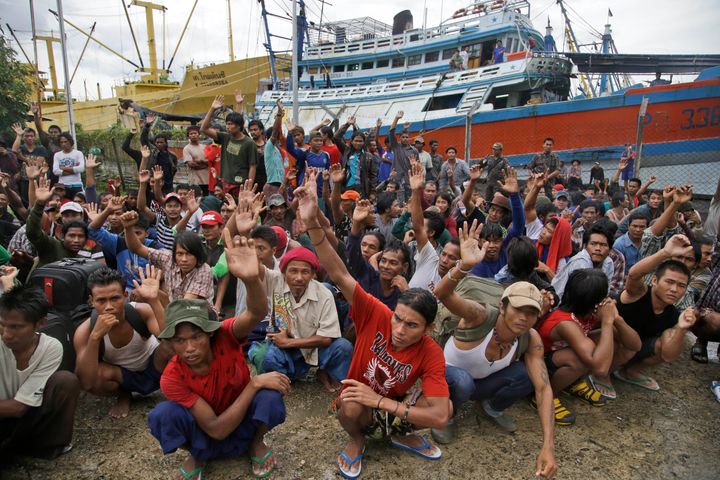
The men in this photo have just been asked “who wants to go home?” by the Indonesian authorities who came to rescue them. The men, mostly from Myanmar, had been trafficked for work on Thai fishing boats. Beaten with sting-ray tails, shocked with Taser-like devices at sea, forced to work almost non-stop without clean water or proper food, they had been paid little or nothing and prevented from leaving.
Coauthored by Kristiina Kangaspunta, Chief, Crime Research Section, UN Office on Drugs and Crime
There are some criminal acts that are so barbaric, it is understandable for an ordinary person to think they ended centuries ago. Such as the practice of luring men to work on fishing boats, then using them as unpaid, forced labour far out at sea where they are literally held captive on board fishing vessels.
Unfortunately, history has a way of repeating itself. Consider the situation of the men in this photo, taken in 2015 by Associated Press as part of Pulitzer Prize winning investigative journalism. Mostly from Myanmar and Cambodia, these men had actively sought work on Thailand’s fishing fleet - thinking they could work and send money home their families. Instead, they were beaten with sting-ray tails, shocked with Taser-like devices, and forced to work almost non-stop without clean water or proper food for years. These men were paid little or nothing and prevented from leaving, until the Indonesian authorities came to rescue them.
We know that these crimes are more likely to occur in situations of extreme chaos and disruption, such as the conflict in Iraq and Syria but also in the massive movements of people that conflict generates, whether in South East Asia, North Africa, Europe or elsewhere. We also see a strong link between the profit motive and modern slavery - too often, modern slavery is a low risk, high profit crime.
While these observations give us some clues on where to find such crimes – and where emergency intervention is needed – we also know modern slavery occurs more widely than just the most extreme or well publicised cases. Moreover, as with other complex crimes such as sexual assault and domestic violence, we know that more cases of trafficking in persons occur than are ever detected by the authorities. Whether in the form of forced labour in many different contexts , trafficking for organ removal or forced marriage, trafficking in persons tends to be deeply hidden and rarely reported. Official statistics do not reflect the actual size of the problem.
The UN Office of Drugs and Crime collects data on officially detected cases of trafficking in persons from Governments worldwide. The biennial Global Report on Trafficking in Persons is based on this data. However, data on detected cases does not reveal the full extent of trafficking in persons.
According to the Global Slavery Index, which draws on survey data rather than official records, there are some 45 million people in some form of modern slavery globally.
For governments to develop informed responses to the crime of trafficking in persons, we collectively need answers to some basic questions. How frequently do these crimes occur, to whom, where and why?
In September 2015, world leaders gathered in New York to adopt the Sustainable Development Goals (or ‘SDGs’). Like their predecessors the Millennium Development Goals, the SDGs chart a course for precisely which of the many development challenges the global community should focus on, to achieve more even economic and social development.
Alongside areas of focus such as poverty, education, hunger and health, the SDGs target some of the most pressing challenges of the day, including the need to end all forms of trafficking in persons and modern slavery.
While the SDGs present challenges for measurement, they also present critical opportunities for a shared focus, a pooling of resources and new collaborations.
As two organisations deeply committed to supporting global efforts to achieve the SDGs, the UN Office on Drugs and Crime, and the Walk Free Foundation, have just signed a new agreement that entails a commitment to pool efforts and resources to generate better estimates of the number of victims of trafficking in persons. Drawing on the expertise of two international experts on human trafficking and statistics, Emeritus Professor Jan Van Dijk and Professor Peter van der Heijden, the project will test and refine a methodology for understanding the prevalence of trafficking in persons in an initial four countries.
This methodology – known as multiple systems estimation – is one that has been applied in both the UK and the Netherlands. According to the UK Government’s estimate, there are between 10,000 – 13,000 people – men, women and children - in some form of modern slavery in the UK. The estimate in the Netherlands, undertaken more recently, is that there are 17,800 victims of some form of trafficking in persons in the Netherlands.
Importantly, such measurements provide the governments of these countries a rare benchmark against which to measure changes in modern slavery over time, and to refine and improve their national responses.
It is only by identifying and measuring the extent of this crime can we build support for action and effective remedy. Walk Free Foundation and UNDOC are joining together to make sure we have the evidence of what we know exists.
